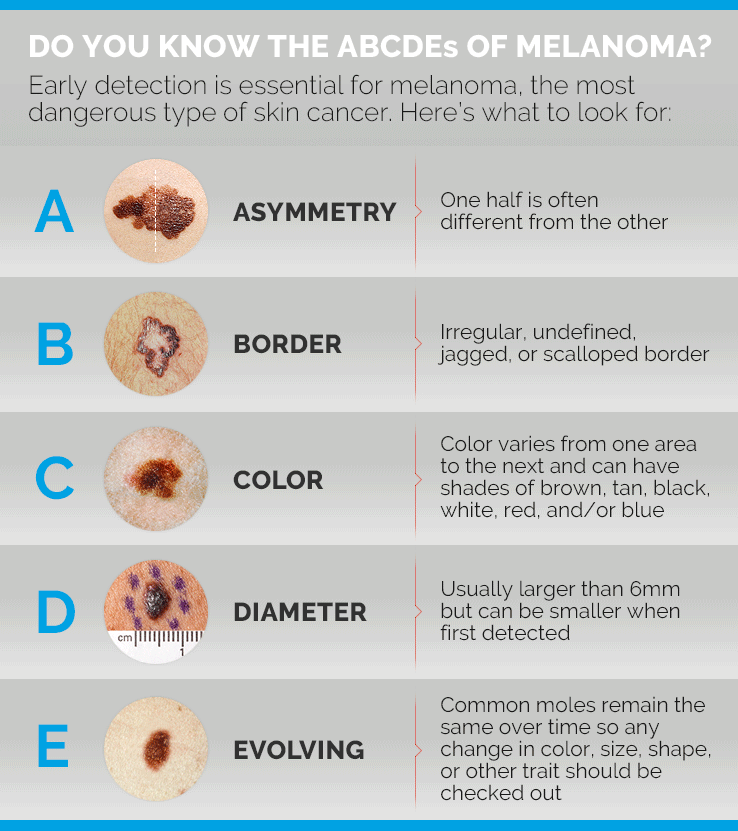What to Know About Moles, and When to Worry
A skin cancer expert shares what you need to know about moles, melanoma, and staying safe in the sun.

Skin cancer is the most commonly diagnosed cancer in the United States, with melanoma being the most dangerous form. One in five Americans will develop skin cancer by age 70. According to the American Cancer Society, many of the more than 5 million skin cancer cases diagnosed each year in the U.S. could be prevented by protecting skin from excessive sun exposure.
Health Matters spoke with Dr. Larisa Geskin, a skin cancer expert and the director of the Comprehensive Skin Cancer Center at NewYork-Presbyterian/Columbia University Irving Medical Center, to discuss moles, melanoma, and the importance of regularly checking your skin for signs of changes.
Can you explain to us what moles are, and how we get them?
Moles are made of the cells called melanocytes. Melanocytes produce pigment called melanin and are evenly distributed through the skin, giving the skin its natural color. People of all races and skin colors have the same number of melanocytes, but melanocytes of darker skin individuals make more melanin. When melanocytes make a cluster, they form a mole.
Moles can come in many colors (brown, pink, white, blue or gray — depending on how much melanin is produced by the melanocytes); sizes (very small or very large, sometimes covering half of the person’s body); and shapes. We usually wind up with moles because of our genetic makeup, but it is also possible to get them as a result of sun exposure. We may be born with some, but they also may develop later in life.
Are moles inherently dangerous?
Moles are not inherently dangerous. On rare occasions, the mole may change and become malignant if the person has a genetic predisposition and, possibly, if they are exposed to harmful sun rays. Those moles may turn into melanoma, the most dangerous form of skin cancer. Having said that, most commonly melanoma starts on normal skin without a pre-existing mole.
What might cause a person to develop melanoma or another type of skin cancer?
There are a few factors that may contribute to a person developing melanoma. The first one is our hereditary disposition, or the genes we get from our parents, which is out of our control. Secondly, age is certainly a factor, because we develop more genetic mutations as we grow older, which are what increase our chances of developing melanoma or other forms of cancer. Lastly, sun exposure plays a large role in our skin health, and if we aren’t careful, it can have detrimental effects.
How can people tell if they have a mole that is developing into melanoma?
A common abbreviation used is the ABCDE test. Each letter stands for a different criterion that is important to check for a mole or skin abnormality. “A” is for asymmetry. If a mole is asymmetrical, meaning if you draw a line down the middle and get two very different halves, it may be a warning sign of skin cancer. “B” is for border, noting that malignant moles may have uneven or notched borders. “C” is for color. Often, benign moles will be one color, so if a mole is multi-colored it may be a warning sign. “D” is for diameter, as malignant moles will usually have a larger diameter than benign ones. And “E” is the most important letter of all of them. It stands for evolution, or change over time in the size, shape, color, or symptoms, such as developing itching, bleeding, or pain in the mole.
Is there one letter in ABCDE that is most important?
I always tell my patients that the “E” for evolution or change is the most important warning sign for melanoma. While some benign moles may be slightly asymmetrical, or may have two colors, any sort of evolution or change in a mole should be taken seriously and could be significant. Moles can transform in many ways — in color and size — but they also may start to become itchy or painful. Don’t brush off the change in the mole as nothing. Seek an evaluation by a specialist.

Photo source: National Cancer Institute
Is melanoma only developed through moles?
Moles are just one way that melanoma develops, but more often than not melanomas may develop on normal skin where a mole wasn’t previously present. There are many types of melanoma; for example, melanoma that arises in the eye, or gut, or on the sole of the foot, on the areas where there are no moles.
The most common melanoma type in individuals with darker skin is the one which happens on the non-sun exposed areas, such as soles of the foot, and are not necessarily associated with a mole. This is different from people with lighter skin, whose melanomas most commonly start on the sun-exposed areas and are frequently associated with the pre-existing mole.
There is a type of melanoma that can develop in a freckle — usually a large freckle — that can change very slowly over time and become darker and multi-colored. Because the change is very slow in this type of melanoma, people may not be able to notice the change. This is why it remains so important to keep an eye on your skin.
How can people be proactive about their skin health?
Everyone should see a dermatologist at least once in their life to figure out what care is necessary for their skin health. For some people who have fair skin and a lot of moles, the dermatologist may recommend that they come in more frequently for melanoma surveillance than someone who has fewer moles and no history of sunburns. We also use a “mole map” — a series of digital images of the whole body’s skin surface (like a world map of your skin). Such maps help us to track the moles over time and detect any changes very early, before they can be noted by a patient. Mole mapping is recommended for anyone who has a personal or family history of melanoma, abnormal moles, fair skin, a lot of moles, and other factors. We find many melanomas and very abnormal moles using this system and use this preventive measure to save a person’s life.
Sun exposure is one of the major risk factors for melanoma. Consequently, people who had many sunburns are at higher risk for melanoma and skin cancer. Excessive sun exposure can also lead to changes in certain types of moles and may increase their chance of transforming to melanoma. While dark skin is protected from the sun by higher levels of melanin, which acts as a shield against harmful UV-rays, all skin tones should be shielded from the sun with some form of sunblock or SPF protection daily.
What is the best thing people can do to protect themselves from having to deal with skin cancer later in life?
People need to be vigilant about their skin and take note of anything abnormal or changing. If you notice something that doesn’t feel right, don’t hesitate to have it checked out. If there is a genetic predisposition for melanoma, focus on what we can do to protect ourselves. One of the clear and well-established risk factors for melanoma and skin cancer is sun exposure. Sun protection is especially important for people who have family history of melanoma, fair skin, and many moles. Sun protective clothing and sunblock use are cornerstones of such protection. Wear a hat and other sun protective clothing, and seek out shade whenever possible.
When choosing a sunscreen, what are some things people should look for on the label?
I recommend a physical sunblock, which contains a high concentration of zinc oxide (at least 10 percent, but more is better; some sunblock products contain as much as 20 percent zinc oxide). It is very important to make sure that you are using enough sunblock (a full shot glass to cover the entire body) and are reapplying frequently, especially if you sweat or swim. Remember that when you look at the SPF it only reflects UVB coverage and not UVA rays, which can also cause skin cancer. Recent studies have shown that people who put on sunblock spend more time in the sun and sunburn more. This is because the sunblock application gives people a false sense of security. Application of a sunblock once a day is not going to be sufficient to protect you from harmful UV radiation. People should be diligent about combining all these measures — frequent application of good sunblock and wearing sun protective clothing.
Is there any truth to media reports that the blue light from digital devices such as smart phones and computers may damage our skin?
There is no scientific literature of any significance available to support any of these claims. Visible light does penetrate the skin, but it does not create inflammation or damage to the skin. For certain types of light to be damaging, we have to use selective photosensitizing medications to activate the light. There is not a shred of significant evidence that the light is damaging to the skin.
Larisa J. Geskin, M.D., is director of the Comprehensive Skin Cancer Center at the Department of Dermatology at NewYork-Presbyterian/Columbia University Irving Medical Center and a professor of dermatology (in medicine) at Columbia University Vagelos College of Physicians and Surgeons.
